Lead generation drives business growth in today’s competitive market. But many companies struggle to choose between inbound and outbound approaches. This creates confusion and wastes valuable marketing budgets.
This guide will clear up that confusion. You’ll learn the key differences between inbound and outbound leads. From practical strategies to ROI analysis, or decision frameworks, we have covered everything you need to know about the approach that fits your business needs.
Inbound leads are your potential customers who found you first and contacted your business, they discovered your company through your content, search results, or social media. These prospects show initial interest before any direct sales contact.
Inbound lead generation works by attracting interested customers who come in naturally. All it takes for you is to create valuable content that solves their problems. This content appears when they search for solutions online. They engage with your brand by downloading guides or signing up for newsletters.
The core philosophy focuses on attraction rather than interruption. You provide helpful information at the right time. Prospects control when and how they engage with your business. This builds trust before any sales conversation begins.
Core principles of inbound methodology:
This approach creates a value exchange that benefits both parties. Prospects get helpful information while you build credibility and trust. The relationship starts with mutual benefit rather than cold interruption.
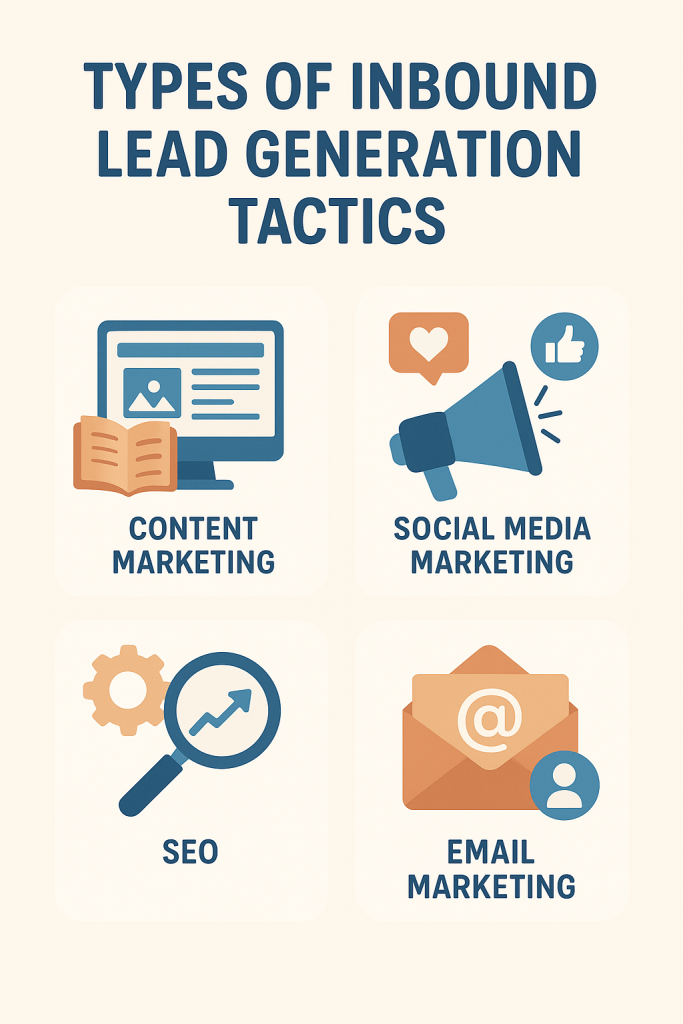
Content Marketing: CM or content marketing works through blog posts that answers common queries to your customers. It could include whitepapers that provide detailed industry insights and can be in the form of Ebooks that offer comprehensive guides on specific topics. Also, in Case studies that show real results from existing customers.
In search engine optimization, keywords are used to determine what prospects are looking for. The on-page optimization of content helps it rank higher on search engines. Technical SEO tools ensure websites load quickly and function properly.
Social Media Marketing: this is where your organic posts share valuable insights with followers, that leads to community engagement and builds relationships over time. Social listening helps identify customer pain points and interests. When combined with ads optimization, these tactics become more effective.
Email Marketing: through several newsletter campaigns that are shared on a regular basis can help as it provides updates and tips. Automated nurture sequences guide customers through the buying process. Personalized content increases engagement and conversion rates.
Video Marketing: Educational videos explain complex concepts clearly. Webinars provide interactive learning experiences. Product demos show features and benefits in action.
Landing Page Optimization: Clean design focuses attention on key messages. Clear calls-to-action guide visitors toward next steps. A/B testing improves conversion rates over time.
Qualified inbound leads show clear interest through specific actions. They engage with multiple pieces of your content. These prospects download resources or attend webinars voluntarily.
Key behavioral indicators include:
Engagement level requirements:
Intent signals show buying readiness through specific behaviors. Prospects research competitors or pricing information. They ask detailed questions about implementation or features. These actions indicate serious consideration rather than casual browsing.
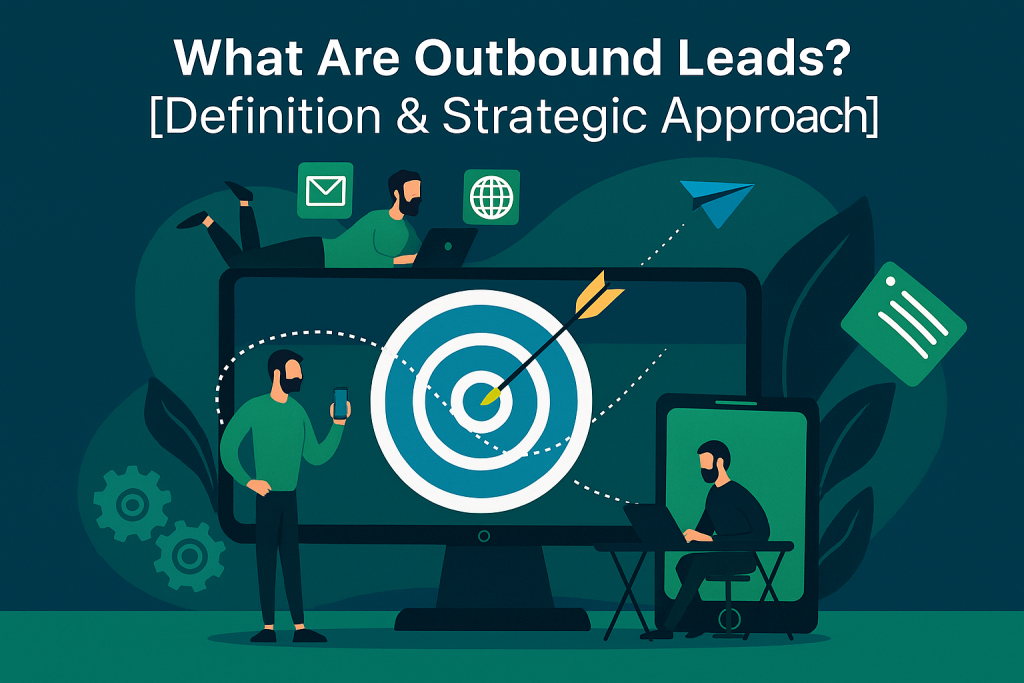
Outbound leads are prospects you identify and contact directly first. Your sales or marketing team initiates the conversation. These leads come from targeted outreach rather than inbound interest.
Outbound methodology involves proactive research and targeted communication. You identify ideal customer profiles and find matching prospects. Then you reach out through various channels with personalized messages. The goal is starting conversations with qualified potential customers.
This approach gives your business control over timing and targeting. You can reach specific decision-makers at chosen companies. Results come faster than waiting for inbound interest. This predictability helps with sales forecasting and revenue planning.
Key characteristics of outbound approach:
Strategic applications work well for specific business situations. New companies need immediate lead flow to survive. Established businesses can target high-value accounts directly. Time-sensitive launches benefit from controlled messaging and timing.
Cold Email Campaigns: Personalized messages address specific customers with their challenges. Email sequences follow up systematically over time. Templates maintain consistency while allowing customization for each customer.
Cold Calling: refers to direct phone conversations that create immediate engagement opportunities. Setting appointments focuses on securing meetings rather than selling. Professional scripts guide conversations while maintaining natural flow.
LinkedIn Outreach: Social selling builds relationships before direct pitches. Connection requests include personalized messages explaining mutual benefits. Regular content sharing establishes expertise and credibility.
Direct Mail: In the middle of an AI driven world physical letters could definitely stand out. These dimensional mailers can create memorable impressions with creative packaging, handwritten notes that add personal touch to business communications.
Paid Advertising: Pay-per-click ads target specific search terms and demographics. On relevant websites, display advertising reaches prospects, and sponsored content appears in social media feeds naturally.
Event Marketing: Trade shows provide face-to-face networking opportunities. Speaking engagements establish thought leadership and expertise. Industry events connect you with qualified prospects actively.
Outbound lead qualification focuses on response and engagement levels. Prospects who reply to emails show initial interest. Phone conversations lasting more than basic politeness indicate genuine consideration.
Response-based qualification metrics:
Engagement level assessment criteria:
Fit criteria evaluation ensures prospects match your ideal customer profile. Company size aligns with your solution capabilities. Budget ranges match your pricing structure. Decision-making authority exists within your contact network.
Interest indicators show genuine consideration rather than polite responses. Prospects ask specific questions about features or benefits. They compare your solution to current processes. These signals indicate serious evaluation rather than casual interest.
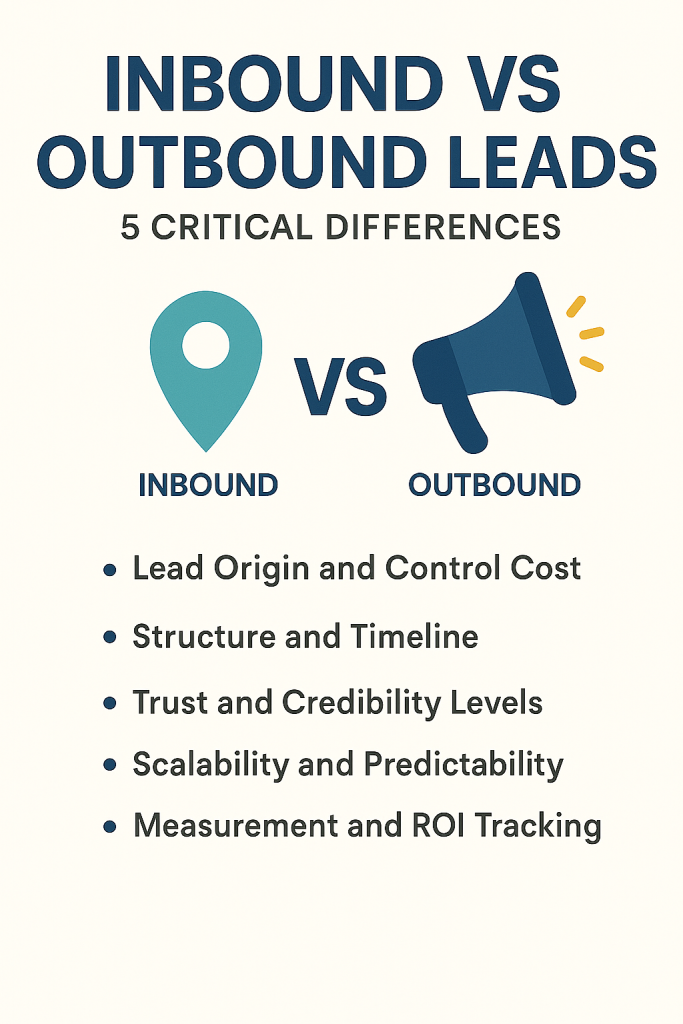
Understanding these key differences helps you choose the right approach. Each method serves different business needs and situations. Smart companies often use both strategies together effectively.
Inbound leads initiate contact when they’re ready to learn more. They control timing and engagement levels throughout the process. Your business responds to their interest rather than creating it.
Outbound leads receive your initial contact based on targeting criteria. You control when conversations begin and messaging content. This approach lets you reach prospects who haven’t discovered you naturally.
Inbound requires significant upfront investment in content and SEO. Results develop slowly but compound over time. Long-term costs decrease as content continues attracting leads.
Outbound involves ongoing costs for each prospect contacted. Results appear quickly with immediate outreach activity. Costs remain consistent as you scale outreach efforts.
Inbound prospects arrive with pre-established trust from your content. They’ve already experienced value through educational resources. This foundation makes sales conversations more natural.
Outbound prospects start relationships from zero trust levels. You must build credibility during initial conversations. Cold contacts require more work to establish rapport.
Inbound scaling happens through content multiplication and SEO improvement. Growth compounds as more content attracts more prospects. However, results fluctuate based on search algorithm changes.
Outbound scaling increases with team size and outreach volume. More salespeople create more prospect conversations directly. Results stay predictable based on activity levels.
Inbound measurement involves longer attribution windows and multiple touchpoints. Prospects engage with various content before converting. This complexity makes exact ROI calculation challenging.
Outbound tracking connects specific outreach activities to results directly. Campaign responses link clearly to revenue outcomes. This transparency makes ROI calculation more straightforward.
Key takeaway: here’s what you need to understand that neither of the approaches is inherently better than the other. The success is going to depend on the matching strategy that sticks to your specific business situation and goals.
Inbound and Outbound Leads, both approaches have a common goal despite having different starting points. Successfully identifying qualified customers requires understanding buyer needs and providing relevant solutions.
Lead qualification requirements remain consistent across both methods. Prospects must have budget, authority, need, and timeline regardless of contact origin. Both approaches benefit from clear ideal customer profiles and scoring systems.
Nurturing and follow-up needs apply equally to all prospects. Inbound leads still require systematic communication after initial contact. Outbound prospects need ongoing value delivery beyond the first conversation. Both groups move through similar decision-making processes.
Technology and tool requirements overlap significantly between approaches. CRM systems track prospect interactions from any source. Email marketing platforms nurture leads regardless of origin. Analytics tools measure performance across all channels.
Sales team handoff processes follow similar patterns universally. Marketing qualified leads need clear criteria and smooth transitions. Sales teams require complete prospect context and interaction history. Both approaches benefit from aligned service level agreements.
Integration possibilities exist when companies combine both strategies effectively. Inbound content supports outbound conversations with relevant resources. Outbound research identifies topics for inbound content creation. This synergy maximizes overall lead generation effectiveness.
Understanding financial implications helps you make smart investment decisions. Both approaches require different resource allocation and timeline expectations. Smart planning prevents budget waste and maximizes returns.
The cost comparison framework considers multiple expense categories. Inbound costs include content creation, SEO tools, and marketing automation platforms. Outbound expenses cover sales team salaries, outreach tools, and lead databases. Both require ongoing technology and personnel investments.
Inbound ROI develops slowly but builds momentum over time. Initial months show minimal returns while content gains search visibility. Month six typically shows first meaningful lead flow. Years two and three often deliver exponential growth as the content library expands.
Average inbound customer acquisition costs decrease over time significantly. Content pieces continue attracting prospects without additional investment. Successful blog posts can generate leads for years after publication.
This compounding effect creates lasting value, which can be measured using customer lifetime value tools. By understanding the long-term worth of each customer, businesses can optimize marketing strategies, enhance retention, and boost overall profitability. This compound effect creates exceptional long-term value.
Outbound ROI expectations focus on immediate and predictable results. Well-executed campaigns generate responses within days or weeks. Monthly results stay consistent with activity levels and targeting quality. Revenue forecasting becomes more accurate with established conversion rates.
Outbound customer acquisition costs remain relatively stable over time. Each prospect requires similar outreach investment regardless of campaign timing. Scaling requires proportional increases in team size and tool costs. This predictability aids in budget planning and growth projections.
Break-even analysis varies significantly between approaches. Inbound investments may take 12-18 months to show positive returns. Outbound campaigns often break even within 3-6 months of launch. Your business cash flow situation should influence strategy selection heavily.
Choosing the right approach depends on multiple business factors. Consider your current situation, resources, and goals carefully. Many successful companies use hybrid approaches combining both methods.
Decision framework evaluation starts with immediate business needs. Companies requiring fast lead generation favor outbound approaches initially. Businesses with longer planning horizons can invest in inbound strategies. Cash flow situations often determine initial strategy selection.
Long-term brand building ranks as a primary objective. Content marketing establishes thought leadership and industry expertise. Educational resources build trust and credibility over time. This foundation supports premium pricing and customer loyalty.
Limited immediate budget exists for outbound team expansion. Content creation costs less than hiring experienced salespeople. One content piece can generate leads indefinitely after creation. This efficiency appeals to resource-constrained businesses.
Complex educational purchase processes characterize your industry. B2B software buyers research extensively before purchasing decisions. Technical products require detailed explanation and comparison information. Inbound content supports these lengthy evaluation processes naturally.
Strong content creation capabilities exist within your organization. Subject matter experts can produce valuable educational resources. Writing and video production skills reduce outsourcing costs. Internal expertise ensures authentic and accurate content development.
Immediate lead generation needs drive current business priorities. New companies need revenue quickly to survive initial stages. Product launches benefit from controlled messaging and timing. Market expansion requires proactive prospect identification and outreach.
Limited organic visibility exists in your current market position. New businesses lack search engine authority and recognition. Competitive industries make organic ranking extremely difficult. Direct outreach bypasses these visibility challenges completely.
High-value targeted prospect lists are readily available. Account-based marketing focuses on specific company targets. Industry databases provide detailed contact information and insights. Personalized outreach becomes more effective with quality prospect data.
Sales team capacity exists for systematic follow-up activities. Experienced salespeople can handle prospect conversations effectively. Established processes support lead nurturing and conversion activities. Team bandwidth allows for consistent outreach volume maintenance.
Hybrid approach considerations combine both strategies for maximum effectiveness. Inbound content supports outbound conversations with relevant resources. Outbound research identifies popular topics for content creation. The whole process increases lead generation efficiency across all channels.
Content quality and consistency form the foundation of successful inbound programs:
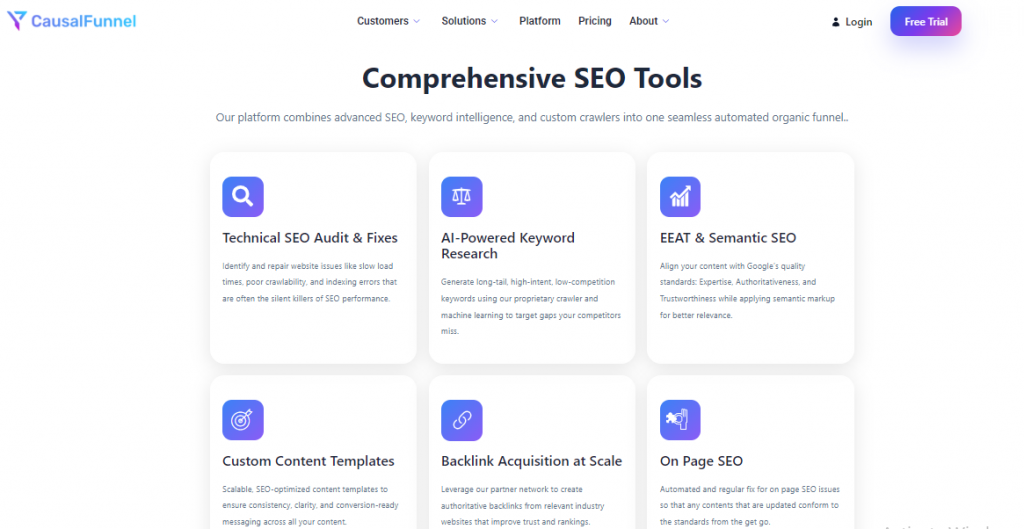
SEO tools play a crucial role in driving content strategy and optimizing search performance. They help identify high-potential keywords, analyze competitors, monitor rankings, and uncover content gaps. Leveraging the right tools allows businesses to make data-driven decisions and ensure their content reaches the right audience effectively.
You need to publish helpful content that addresses real customer problems regularly. For that you need to maintain editorial content calendars ensuring steady content flow throughout months/year. Focus on depth rather than quantity for maximum impact.
Also, you need to research competitors’ content gaps and create even better alternatives. Use customer FAQs as inspiration for new topics. Update existing content regularly to maintain search rankings and relevance.
SEO and keyword optimization drive organic discovery and traffic growth. To have a study growth you need to target long-tail keywords with clear intent signals. With Optimize page titles, headers, and meta descriptions for search visibility, you gain the advantage to have better inflows on your page. Build internal links connecting related content pieces naturally.
The process also involves monitoring search performance and adjusting strategies as needed. Focus on featured snippet optimization for high-volume question keywords, and use local SEO tactics for businesses targeting specific geographic markets.
Lead gaining automation guides prospects through decision-making processes systematically. Use content engagement and demographic characteristics to segment email lists. Provide relevant information at appropriate intervals through drip campaigns. Score leads based on behavior to identify sales-ready prospects.
Personalize email content using available prospect data effectively. A/B test subject lines and content formats for optimal performance. Track email metrics and adjust campaigns based on response patterns.
Personalization at scale requires systematic research and message customization. Use prospect company news and social media activity for conversation starters. Reference specific challenges relevant to their industry or role. Avoid generic templates that sound obviously mass-produced.
Implement research tools that provide prospect insights efficiently. Train team members on personalization techniques that save time. Create templates allowing easy customization without complete rewriting.
Multi-channel approach increases response rates and prospect engagement opportunities. Combine email, phone calls, and social media for comprehensive outreach. Vary contact timing and methods to accommodate different preferences. Track channel performance to optimize resource allocation using Ads Optimizer.
Coordinate messaging across channels for consistent brand representation. Allow prospects to respond through their preferred communication methods. Use channel preferences to inform future outreach strategies.
Timing and frequency optimization prevents prospect fatigue while maintaining visibility. Test different days and times for optimal response rates. Space follow-ups appropriately based on prospect behavior and industry norms. Respect unsubscribe requests and communication preferences immediately.
Monitor response patterns to identify optimal contact frequencies with Customer Lifetime support system. Adjust cadences based on prospect engagement levels and feedback. Stop outreach when prospects show clear disinterest signals.
Data sharing between approaches creates comprehensive prospect views. Connect marketing automation and CRM systems for seamless information flow. Track prospect interactions across all touchpoints and channels. Use combined data for more effective personalization and targeting.
Organic traffic growth indicates content effectiveness and search visibility improvement:
SEO Tools can help monitor monthly visitors from search engines and referral sources. Track keyword rankings for target terms and phrases. Measure click-through rates from search results pages.
Set quarterly traffic growth targets based on content production schedules. Compare performance against industry benchmarks for realistic expectations. Focus on qualified traffic rather than total volume metrics.
Content engagement rates show audience interest and value perception:
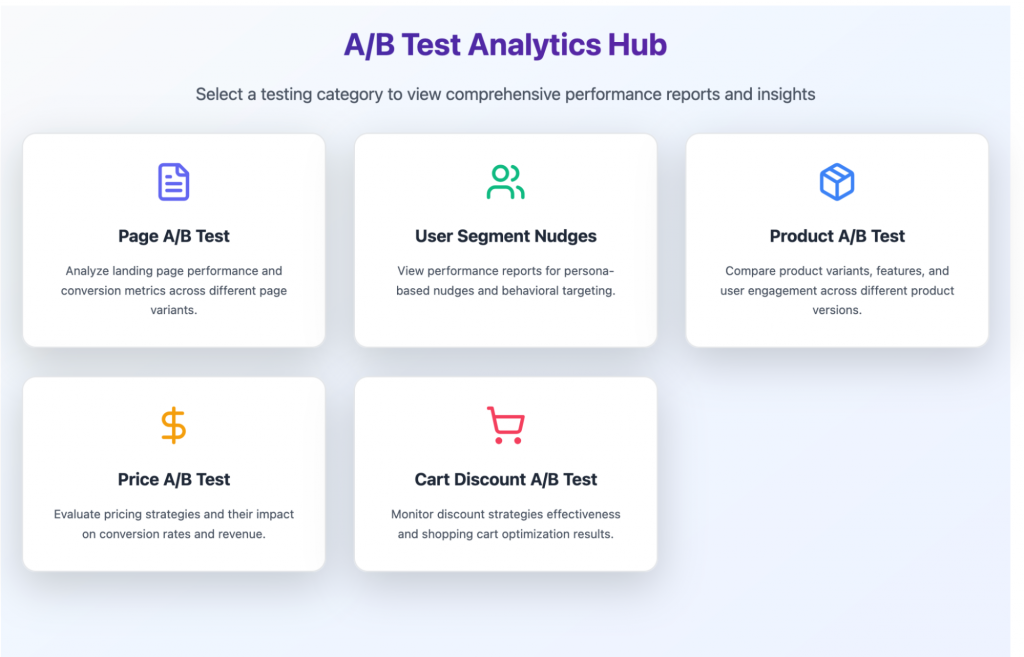
A/B tests can then optimize these metrics by testing different page layouts, calls-to-action, or content formats.
It is easy to track time spent on pages, bounce rates, and social shares along with monitoring download rates for content and resource materials. Measure email newsletter open rates and click-through percentages.
Lead conversion rates reveal content effectiveness at generating prospects. Calculate visitor-to-lead conversion percentages across different content types. Measure form completion rates on landing pages and resource downloads. Track email subscription growth from organic sources.
Response and conversion rates measure outreach campaign effectiveness directly. Track email open rates, reply rates, and positive responses. Monitor phone call connection rates and conversation lengths. Measure meeting booking rates from initial outreach efforts.
Calculate conversion rates with A/B test platforms from initial contact to sales qualified leads. Compare performance across different message types and channels. Adjust tactics based on response pattern analysis.
Cost per lead and acquisition metrics guide budget allocation decisions. Calculate total campaign costs divided by qualified leads generated. Track sales cycle length from first contact to close. Measure lifetime value compared to acquisition investment.
Pipeline velocity shows how quickly outbound leads progress toward closure. Monitor time spent in each sales stage systematically. Identify bottlenecks causing delays in prospect progression. Optimize handoff processes between marketing and sales teams.
Success measurement requires context and comparison across both approaches. Track leads by source to understand channel effectiveness. Compare cost per lead between inbound and outbound methods. Analyze conversion rates and sales cycle differences by lead origin.
AI and automation impact both approaches through improved personalization and efficiency:
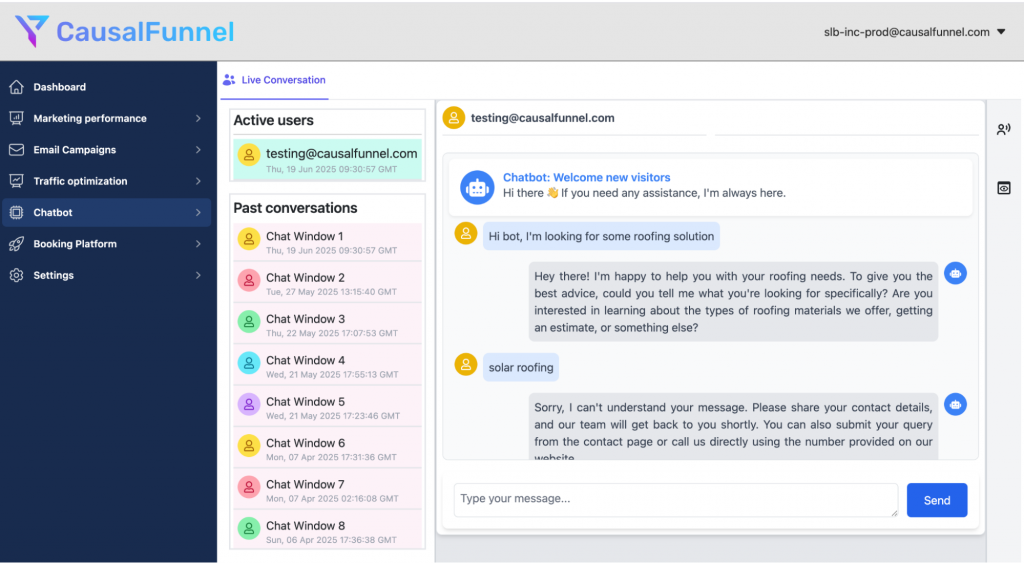
Machine learning algorithms identify ideal prospect characteristics more accurately. Automated content creation tools help scale educational resource production. Chatbots handle initial prospect qualification and routing automatically. AI Chatbots instant responses to inquiries anytime, improving customer experience.
Predictive analytics identify prospects most likely to convert successfully. Dynamic content personalization improves engagement rates across all channels. Voice and visual search technologies change how prospects discover solutions.
Privacy regulations affect data collection and outreach methods significantly:
GDPR and similar laws restrict prospect data usage and storage. Email regulations require explicit consent for marketing communications. Cookie restrictions limit website visitor tracking capabilities.
Companies must adapt strategies to comply with evolving privacy requirements. First-party data collection becomes increasingly important for targeting. Permission-based marketing gains advantage over interruptive approaches.
Buyer behavior evolution influences strategy effectiveness and channel preferences:
Remote work changes how business decisions get made. Digital-first interactions become standard across industries. Self-service research preferences reduce sales interaction desires.
Mobile-first content consumption affects format and delivery requirements. Social proof and peer reviews influence decisions more heavily. Community-driven learning replaces traditional sales presentations gradually.
Hybrid model innovations combine the best elements from both approaches strategically:
Social selling blends relationship building with direct outreach techniques. Account-based marketing uses targeted content for specific Customers. Conversational marketing engages prospects through real-time chat interactions.
Both inbound and outbound approaches offer unique advantages for different business situations. Inbound builds long-term assets and credibility through valuable content creation. Outbound provides immediate results and targeting control for specific objectives.
Strategic recommendations focus on hybrid approaches combining both methods effectively. Start with your immediate business needs and available resources. Use outbound for quick wins while building inbound capabilities. Integrate data and insights across all lead generation activities.
Consider your industry, target market, and competitive landscape carefully. Test both approaches systematically to understand what works best. Measure results consistently and adjust strategies based on performance data.
Implementation next steps begin with clear goal setting and resource allocation. Define success metrics for each approach you choose to pursue. Assign team responsibilities and establish regular review schedules. Invest in tools and training necessary for effective execution.
Start small with one approach and scale gradually based on results. Document successful processes for team training and consistency. Remain flexible and adapt strategies as markets and technologies evolve.
Empowering businesses to optimize their conversion funnels with AI-driven insights and automation. Turn traffic into sales with our advanced attribution platform.



